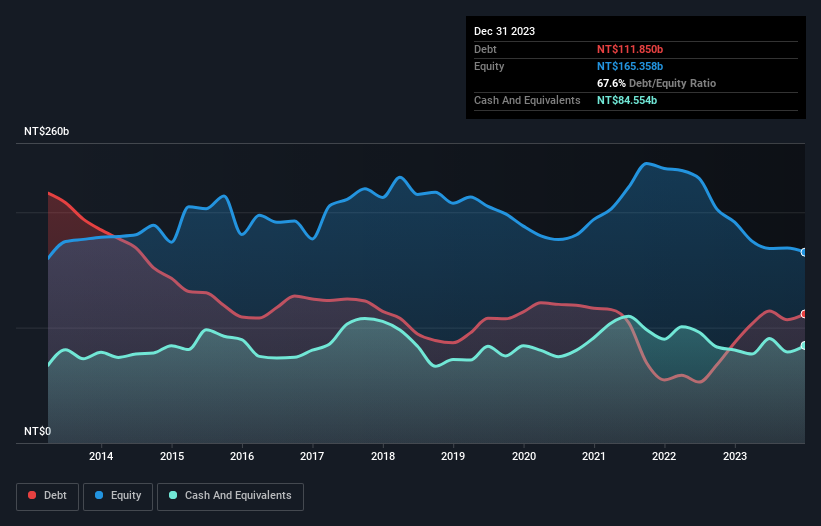- Taiwan
- /
- Electronic Equipment and Components
- /
- TWSE:2409
Does AUO (TWSE:2409) Have A Healthy Balance Sheet?
Warren Buffett famously said, 'Volatility is far from synonymous with risk.' So it might be obvious that you need to consider debt, when you think about how risky any given stock is, because too much debt can sink a company. We can see that AUO Corporation (TWSE:2409) does use debt in its business. But is this debt a concern to shareholders?
When Is Debt Dangerous?
Debt and other liabilities become risky for a business when it cannot easily fulfill those obligations, either with free cash flow or by raising capital at an attractive price. Ultimately, if the company can't fulfill its legal obligations to repay debt, shareholders could walk away with nothing. However, a more frequent (but still costly) occurrence is where a company must issue shares at bargain-basement prices, permanently diluting shareholders, just to shore up its balance sheet. Having said that, the most common situation is where a company manages its debt reasonably well - and to its own advantage. The first step when considering a company's debt levels is to consider its cash and debt together.
View our latest analysis for AUO
How Much Debt Does AUO Carry?
The image below, which you can click on for greater detail, shows that at December 2023 AUO had debt of NT$111.9b, up from NT$86.9b in one year. On the flip side, it has NT$84.6b in cash leading to net debt of about NT$27.3b.

How Healthy Is AUO's Balance Sheet?
We can see from the most recent balance sheet that AUO had liabilities of NT$94.6b falling due within a year, and liabilities of NT$123.5b due beyond that. Offsetting these obligations, it had cash of NT$84.6b as well as receivables valued at NT$25.7b due within 12 months. So it has liabilities totalling NT$107.9b more than its cash and near-term receivables, combined.
This is a mountain of leverage relative to its market capitalization of NT$141.1b. Should its lenders demand that it shore up the balance sheet, shareholders would likely face severe dilution. The balance sheet is clearly the area to focus on when you are analysing debt. But it is future earnings, more than anything, that will determine AUO's ability to maintain a healthy balance sheet going forward. So if you're focused on the future you can check out this free report showing analyst profit forecasts.
In the last year AUO's revenue was pretty flat, and it made a negative EBIT. While that's not too bad, we'd prefer see growth.
Caveat Emptor
Over the last twelve months AUO produced an earnings before interest and tax (EBIT) loss. Its EBIT loss was a whopping NT$22b. When we look at that and recall the liabilities on its balance sheet, relative to cash, it seems unwise to us for the company to have any debt. Quite frankly we think the balance sheet is far from match-fit, although it could be improved with time. Another cause for caution is that is bled NT$17b in negative free cash flow over the last twelve months. So in short it's a really risky stock. When we look at a riskier company, we like to check how their profits (or losses) are trending over time. Today, we're providing readers this interactive graph showing how AUO's profit, revenue, and operating cashflow have changed over the last few years.
At the end of the day, it's often better to focus on companies that are free from net debt. You can access our special list of such companies (all with a track record of profit growth). It's free.
New: Manage All Your Stock Portfolios in One Place
We've created the ultimate portfolio companion for stock investors, and it's free.
• Connect an unlimited number of Portfolios and see your total in one currency
• Be alerted to new Warning Signs or Risks via email or mobile
• Track the Fair Value of your stocks
Have feedback on this article? Concerned about the content? Get in touch with us directly. Alternatively, email editorial-team (at) simplywallst.com.
This article by Simply Wall St is general in nature. We provide commentary based on historical data and analyst forecasts only using an unbiased methodology and our articles are not intended to be financial advice. It does not constitute a recommendation to buy or sell any stock, and does not take account of your objectives, or your financial situation. We aim to bring you long-term focused analysis driven by fundamental data. Note that our analysis may not factor in the latest price-sensitive company announcements or qualitative material. Simply Wall St has no position in any stocks mentioned.
About TWSE:2409
AUO
Engages in the research, development, production, and sale of thin film transistor liquid crystal displays (TFT-LCDs) and other flat panel displays for various applications.
Undervalued with mediocre balance sheet.
Similar Companies
Market Insights
Community Narratives



